6 Benefits Of Making Prints Of Your Photographs
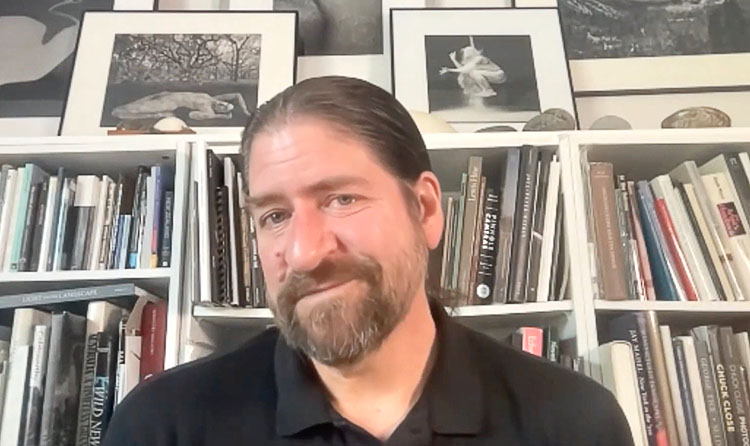

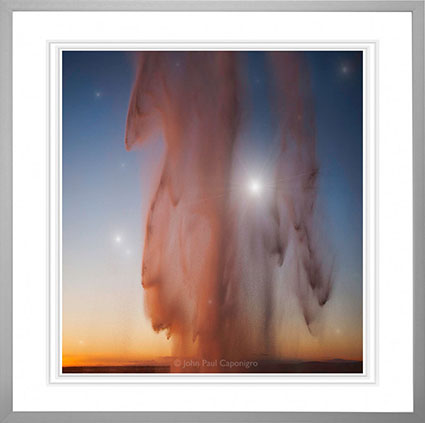
Almost everyday, we make, collect, sequence, process, and share our photographs on digital devices with screen. When was the last time you made a print? If you haven’t made prints recently, you’re missing out. Making prints does many things for you.
How many things? Let me count the ways …
You Connect
When you’re having a hard time believing something, you want to confirm what you see by touching it. Once you touch it, it’s hard to deny – and you learn more about it. Touch is an essential part of a doctor’s diagnosis and healing practice. When you touch and are touched by something you make a special connection. When you make your images physical, you can touch them and they will touch you. This works for other people who get to experience your prints too.
You Look More Carefully
When you make a print you consider your images more carefully. Along the way, you’ll find many ways to improve your images. This adds up. You learn not only what to look for but also what’s possible. You train yourself to look closer and deeper. If you make this a regular practice you’ll find your vision as a whole will improve.
You Develop A Relationship
When you make prints you look at your images more often. While you’re printing them you look at them very carefully, so carefully that sometimes you need to take a break to find perspective. After you print them, you still look at them more carefully at first, but this tends to diminish over time, even though it’s always an option. Because a print persists in your environment you’ll find you also look at your images casually too, sometimes you just see them out of the corner of your eye … and your subconscious registers this. Prints create an accumulation of perception, which deepens your understanding of images on many levels. Once again, this happens for people who view your prints too.
You Decide What’s Most Important
You make a lot of photographs. How many get printed? One percent? Only the best and the most important images are worth printing. Print an image and it makes a statement, simply because it’s printed.
Inevitably, when making a print some things are gained and others are lost. The sacrifices you are willing to make offer still more opportunities for you to clarify your vision. What are you willing to compromise on? What aren’t you willing to compromise? When you make these choices you make a statement, to yourself and others.
You Choose How You’d Like Your Images To Be Received
The many new opportunities making prints presents will challenge you to clarify and declare your creative goals. The way you choose to print (or not to print) your images will encourage people to look at, interact with, share, and value them in entirely different ways. How would you like your images to look? How would you like others to look at your images? How do you want people to interact with your images? Do you want to present your images as casual, every day, highly accessible, utilitarian artifacts or scarce, highly refined, collectibles? If your goal is to make a historic record you may be content with making a few, perhaps only one, possibly quite small, highly durable print that is stored and preserved very carefully for the future appreciation of only a few. On the other hand, if your goal is to expose the largest number of people possible to your imagery, you may want to consider creating an international billboard campaign. There is no right or wrong answer to this question. There is your answer – if you make a print.
You Learn About Yourself
You learn a lot about your images and yourself when you make a print. Realizing your vision in print means more than just making it real, it also means making many realizations along the way. To make a print you have to make a number of decisions. The choices you make reflect your personal likes and dislikes. Go beyond simply saying “I like it.” or “I don’t like it.” Next, ask “Why?” Answering this all-important question will make your personal vision and style clearer. It will make it clearer to people you share your prints with too.
You Share Your Journey
The things you make your images into will guide your audience through a reenactment of your journey of discovery – selecting your subject, composing it, exposing it, processing it, printing it, and sharing it. Prints offer invitations for others to carefully consider not only what you’ve seen, but also the way you’ve see it, and the ways you’ve chosen to share it.
Sure, you can let others make prints for you. Sometimes you have to. But, when you do, you’ll be missing out on many of the opportunities printing presents to further clarify, refine, strengthen, and fulfill your vision. So will your viewers. Even if you print, really print, just once, you’ll learn a lot.
Read What Printing Can Do For Your Images.
Read more in my Printing Resources.
Learn more in my digital printing workshops.
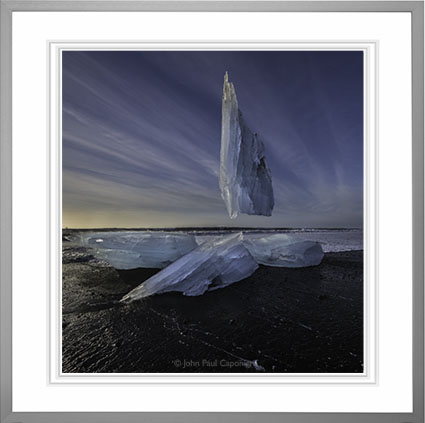
Most of us carry and share albums of our photographs with our phones every day. When was the last time you carried prints of your images with you? When was the last time you made a print? If you haven’t made prints recently, you’re missing out. So are your images. Making prints does many things for your images.
How many things? Let me count the ways …
Sensual
Prints make your images tangible. Prints enhance your images with material qualities and the associations they bring with them. Synthetic or organic? Reflective or non-reflective? Smooth or textured? Uniform or irregular? Sharp or soft? White or cream? Transparent or metallic? These and many other factors will have an impact on the technical quality of your images (color, detail, gradation, etc) and on the reactions they produce within their viewers (“It feels like or reminds me of …”).
Scaled
Prints define the scale of your images. What is the appropriate scale for an image – miniature, life-sized, or larger-than-life? Do you want people to walk up to a building-sized mountain or hold it in their hands? Scale changes the physical and psychological reactions people have to images. They draw close to small prints and sometimes hold them or even carry them with them wherever they go; large prints immerse people in images that may fill their entire visual field until they pull back to view them from a distance. You can change a space or even create new space with prints.
Durable
Printing makes your images more durable. So far, it’s prints that have stood the test of time. Historically, it’s the images that were printed that survived. Putting new technology disaster stories aside, there’s never been a precedent to help us determine how long digital files will last if properly cared for. In theory, they should never degrade and can be copied indefinitely without reducing their quality. Whether people, first you and later the inheritors of your images, will perform the required maintenance to ensure this is the real question. One day in the future, media and format migration may become automated, but it’s not now. Consider prints your ultimate form of backup. Though they can deteriorate on their own, if properly produced and stored, prints need little or no additional care and no know how to retrieve and use them.
Saleable
Because they’re physical, prints are easily bought and sold. It’s hard to command a high price for intangible things and harder still for them to hold their value or appreciate. In recent years, there have been unprecedented escalations in the value of photographic prints. Photographic prints have sold for as much as major paintings.
Exclusive
Images in print are more rare as well as less accessible. (Often, this contributes to both their market and personal value.) Prints take up physical space and why would you let something do that if it wasn’t important? Of all the images you look at in a day, how many of them are prints? No one carries thousands of prints in their pockets or on their cell phones. No one makes millions of prints. How many prints do you make? Most of us don’t make enough prints. Making a print is a statement.
Different Experiences
Traditionally, to be viewed at all photographs needed to be printed. Today, that’s no longer true. Still, prints encourage images to be viewed in different ways. If you’re like most people, only the most important images to you have been printed and only a few of those are displayed at one time or for long periods of time. We look at images that are printed differently than images that are not. Do you look more frequently and longer at images that have been printed or images that haven’t? Prints persist. They remain in our environment consistently and require little or no conscious effort for us to consider and reconsider them yet often they demand that we do look at them more consciously. Making prints can become a part of the decision-making process to focus more attention on a select few images. When images are printed they are no longer lost amid so many other less important images. When printed your images become more significant.
In short, printing your images can work wonders for them. It can also work wonders for you.
Read What Making Prints Can Do For You.

One of the keys to making a great print is great shadow detail.
Shadow detail is something to be mindful of during exposure, processing, and printing. Curiously, even if you see shadow detail in your file on a calibrated monitor you may not see all of the details in your print. What can you do about this? Many things!
First Check Your Color Management
Before you start editing your files based on your proofs, check your color management system.
Recalibrate Your Monitor
Make sure you’ve calibrated your monitor with hardware. Set a brightness value of 90-100 lux, instead of using the default brightness target of 120 lux. If your monitor is too bright, your prints will look dark overall, especially in your shadows.
Read more on Profiling Your Monitor here.
Give Your Prints Enough Time To Dry
Inkjet prints come out of the printer almost dry, but not quite fully dry. When they’re fully dry, they’ll appear slightly lighter, especially in the shadows where there’s a lot of ink. So before you evaluate prints critically, give them a few minutes to dry. This affects absorbent matte surfaces even more than glossy surfaces.
Find my resource on Outgassing here.
Look At Your Prints In Good Light
Look at your prints in good light. You need the right amount of light (at least 500 lumens), the right color temperature light (5000K is the standard but many viewers prefer the warmer 3600K), and it helps to use full-spectrum light (a CRI of 90 or higher). (Many manufacturers now make full spectrum bulbs, like Solux and Soraa.)
Read more on Controlling Your Environment here.
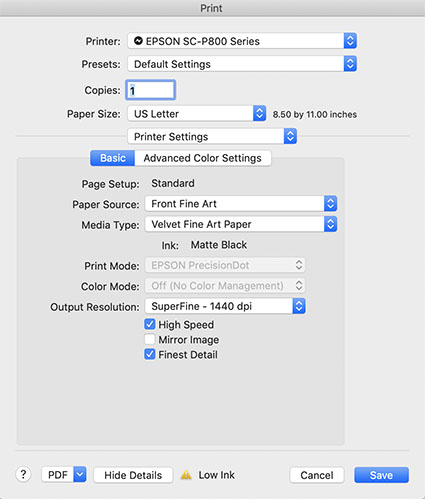
Media Type sets the amount of ink that's used.
Set Your Media Type Correctly
Your printer driver will allow you to set your media type, which controls ink the amount of ink that is sprayed on your paper. Use too much ink and you’ll lose shadow detail. Use too little and your blacks and midtones will appear weak. If you’re using a paper not made by the manufacturer, choose the nearest media type and then adjust its settings with the printer driver’s advanced utilities. (You’ll find this under Advanced Media Control with Epson printers.)
Find my resource on Ink Limit here.

Print test patches to determine when maximum black is achieved and when separation is lost.
Print A Target To Determine How Much To Lighten Shadows
Before you adjust your files for printing precisely determine how much you need to lighten your deep shadows by printing a target. While they vary a little, most media settings lose shadow detail around a value of 96% on a grayscale. If you print patches of values between 100% and 90% you’ll see exactly where you lose shadow detail. Printed results will vary slightly with each different media setting, so you’ll need to adjust files slightly differently for different media.
You can download my targets here.
Next Adjust Your File
.
In this video my father and I share insights into our creative lives and our passion for printing.
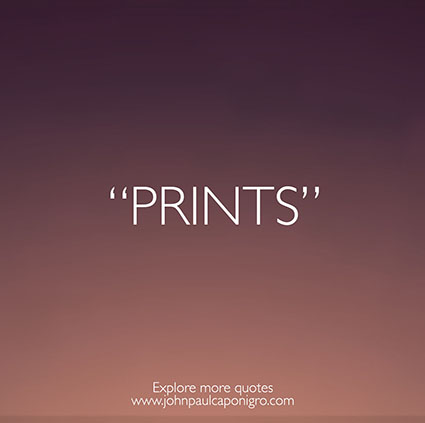
Enjoy this collection of quotes on photographic Prints.
“We should always remember that the practice of printing – of using an object to control the form of a repeated picture – has had a role in human culture from its earliest days.” – Richard Benson
“Fine art prints created by the artist, or the artist’s collaborator, are important because they best represent the artist’s vision. Images displayed on digital devices are subject to the non-uniform nature of different displays and they may appear radically different than the artist intended.” – Mac Holbert
“My ideal is to achieve the ability to produce numberless prints from each negative, prints all significantly alive, yet indistinguishably alike, and to be able to circulate them at a price not higher than that of a popular magazine or even a daily paper. To gain that ability, there has been no choice but to follow the road I have chosen.” – Alfred Stieglitz
“Regarding rumors that the digital age is soon to render photographic prints as being no longer necessary or relevant (due to increasing numbers of photographic images being viewed on electronic monitors), speculators overlook the tremendous importance and historic relevance of the physical artifact as being a uniquely necessary and applicable aspect of photographic art. The electronic image could no more replace a fine photographic print than a synthesizer could replace a violin!” —Huntington Witherill
“When you make a print, you are making an art object. You can’t hang a scan on the wall.”- George Tice
“The print is an idea made visible. For my process, a photograph isn’t a photograph until it’s a print. I love the physical presence of a print from beginning to end. For me it’s a tactile, sensual experience. I want it to be an object of beauty, whether the subject moves you or not.” – Tillman Crane
“A photograph doesn’t feel real until it is a tangible physical object I can hold in my hand.” – Stephen Johnson
“A beautiful print is a thing in itself, not just a halfway house on the way to the page.” – Irving Penn
“A picture is worth a thousand words; A fine art print so much more.” – Steve Denby
“Mostly, I worked so quickly, I didn’t see the details of a photograph until it was printed.” – Harold Feinstein
“I was a very, very careful printer when I used 8-by-10 film. I probably spent more time on printing than anything else. The more the prints were appreciated, the more time I spent on them.” – Ruth Bernhard
“I think that it is a sensual pleasure – image making. It’s not just the finished print, which is sensual in terms of the tactile qualities of the materials that I use. I’m seduced by the light, all the time.” – Elizabeth Opalenik
“You will often see that it is the unexpected accident, in tandem with your practice, that will transform the science to art.” – Christopher James
“I like to think one of art’s greatest techniques is creative stumbling, where missteps lead to creative encounters. Digital printing is an adequate place to falter — the wet darkroom is a veritable minefield of happy stumbling opportunities.” – Dan Burkholder
“For me the printing process is part of the magic of photography. It’s that magic that can be exciting, disappointing, rewarding, and frustrating all in the same few moments in the darkroom.” – John Sexton
“To convey in the print the feeling you experienced when you exposed your film – to walk out of the darkroom and say: ‘This is it, the equivalent of what I saw and felt!’. That’s what it’s all about.” – John Sexton
“The negative is the equivalent of the composer’s score, and the print the performance.” – Ansel Adams
“In my mind’s eye, I visualize how a particular… sight and feeling will appear on a print. If it excites me, there is a good chance it will make a good photograph. It is an intuitive sense, an ability that comes from a lot of practice.” – Ansel Adams
“Some of my photographs have always been a mystery to me in terms of how I arrived at them. Even with the technical ability to produce fine prints, I am hard put to know how it happens, yet unless technique and materials are seriously investigated and experienced, I see that moving statements are seldom made.” – Paul Caponigro
“All that I have achieved are these dreams locked in silver.” – Paul Caponigro
“When you make prints you deepen your relationship with your images.” – John Paul Caponigro
“It’s the last 5% in quality that separates the good prints from the great prints.” – John Paul Caponigro
“We used to have to make prints in order to view certain images, particularly black and white ones. Now you don’t. But for many of us, prints are still very much desired – I think they always will be. Physical prints do many things that no other method of presentation does. With a print, you experience an image in combination with specific materials, which enhance expression. You experience a print at specific scales, which has an impact on how an image is viewed and, in many cases, modifies the message the image conveys. Prints offer non-powered portability; they can be retrieved and distributed at a moment’s notice to anyone without the need for other supporting devices or additional communication. Prints can be displayed in ways that make an image’s presence more durable, affecting and even shaping the environments they inhabit; with sustained viewing, this can add additional depth to looking. Prints are collectible. While the time-honored tradition of printmaking is currently evolving rapidly (so rapidly that it would be fair to say it is experiencing a profound paradigm shift), it is very much with us today and will be for the foreseeable future.” – John Paul Caponigro
“When you look at a photograph that is printed, you are free of distraction, allowing you to really engage and experience all that it has to offer. The experience triggers an emotional response very different from simply seeing an image for a fleeting moment on a screen. The print is a finished product that engages the viewer. People want to move closer and even touch a print. Viewing a print encourages the viewer to travel into the frame imagining the experience of being in that place.” – Seth Resnick
“The fine print is much more than a mere reproduction of an image. It is the culmination of the inspiration and vision of the photographer. It is the clearest, most direct, and most powerful form of the image and has the ability to move beyond words, ideas, and concepts to touch and move the viewer in the most direct and immediate way. In its highest form, the fine print can be a transparent vehicle, boldly communicating with whispers and suggestions of worlds previously unseen and unknown. No other form of the image can convey as powerfully the subtleties, the presence, and the luminosity which exists in the fine print.” – Christopher Burkett
“Something happens between a novel and its reader, which is similar to the process of developing photographs, the way they did it before the digital age. The photograph, as it was printed in the darkroom, became visible bit by bit. As you read your way through a novel, the same chemical process takes place.” – Patrick Modiano
“I consider it essential that the photographer should do his own printing and enlarging. The final effect of the finished print depends so much on these operations.” – Bill Brandt
“I set myself up in opposition to the thing that I’m going to photograph and I try and find a place to stand so that when the image is made, a visual resonance is engaged between me and the subject. I can then take that image and amplify it in any number of different directions as I take it into the print-making process. And then, when the print is seen by someone else, whether I’m there or not, hopefully, what I’ve put into that piece will initiate another situation of resonance between the print and the viewer. That’s what’s really important to me.” – Craig Stevens
Explore The Essential Collection Of Creativity Quotes here.
View The Essential Collection Of Creativity Videos here
Discover more quotes in my social networks.
Jeremy Cowart
Gregory Crewdson
Loise Greenfield
Download The Digital Printing Quick Start Guide here.
Read more on digital printing here.
Learn more in my digital photography and digital printing workshops.
Workshop
Black & White Mastery
December 12-16, 2016
Test the latest Epson printers, inks, and papers. They’re the best ever!
Learn the heart of Adobe Lightroom & Photoshop including the latest advances.
This workshop closely follows the content of my most popular workshop, The Fine Digital Print Intermediate, diving more deeply into black and white imagery.
The Fine Art Digital Printing workshop series offers the most advanced digital printing workshops available anywhere. You’ll learn more in one week than you learn in a semester in college.
Save 10% / $160 – Register By Nov 18
Alumni, save an extra 10% / $160
A unique Father/Son Print edition featuring two images
Offer ends Monday 12/15 at 5 pm PST.
It makes a great Christmas gift!
Prints have already started shipping!
Plus get a free Two Generations ebook with every print.
$495
$44.95 shipping domestic – FedEx
$79.95 shipping international – USPS
Paul Caponigro – Nahant, MA, 1965
Paper size – 17”x22”
Image size left – 9.7”x7.25”
Image size right – 8.75”x7.25”
Epson Velvet Fine Art Paper
Epson Ultrachrome K3 with Vivid Magenta
Signed en recto by both artists in pencil.
Numbered and annotated en verso.
Limited to the number of prints sold for five days only.
Offer ends Monday 12/15 at 5 pm PST.
It makes a great Christmas gift!
Prints have already started shipping!
A unique Father/Son Print edition featuring two images
Offer ends Monday 12/15 at 5 pm EST.
It makes a great Christmas gift!
Plus get a free Two Generations ebook with every print.
$495
$44.95 shipping domestic – FedEx
$79.95 shipping international – USPS
Paul Caponigro – Nahant, MA, 1965
Paper size – 17”x22”
Image size left – 9.7”x7.25”
Image size right – 8.75”x7.25”
Epson Velvet Fine Art Paper
Epson Ultrachrome K3 with Vivid Magenta
Signed en recto by both artists in pencil.
Numbered and annotated en verso.
Limited to the number of prints sold for five days only.
Offer ends Monday 12/15 at 5 pm EST.
It makes a great Christmas gift!